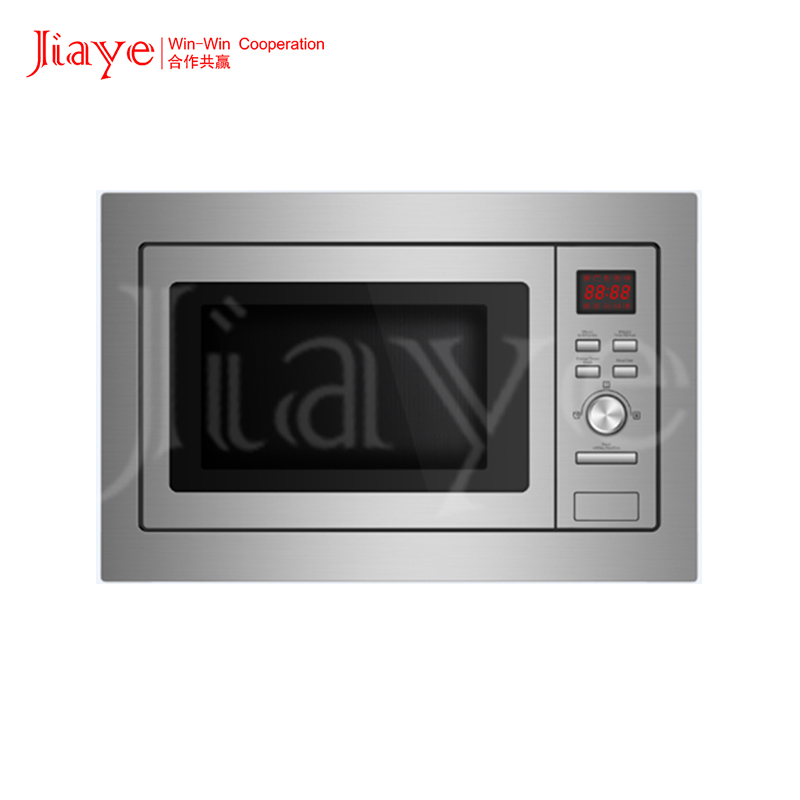- All
- Product Name
- Product Keyword
- Product Model
- Product Summary
- Product Description
- Multi Field Search
Views: 0 Author: Site Editor Publish Time: 2025-09-28 Origin: Site

Microwave ovens are essential kitchen appliances, providing convenience and speed in meal preparation. However, many users often wonder about their lifespan and the factors that influence how long they will last. Understanding the key elements that affect a microwave's durability—such as quality, frequency of use, and maintenance practices—can help you make informed decisions when purchasing and caring for your appliance. In this article, we will explore the average lifespan of microwave ovens and offer tips to extend their longevity.
Several key factors influence how long a microwave oven lasts. Understanding these helps you make smart choices when buying and maintaining one.
The quality of your microwave plays a crucial role in its lifespan. High-quality models use better materials and components, which tend to last longer. Trusted brands often invest more in durability and reliability. Cheaper microwaves may save money upfront but often fail sooner due to lower-grade parts. When shopping, look for reviews and warranties as indicators of quality.
How often you use your microwave directly impacts its longevity. A microwave used multiple times daily will wear out faster than one used occasionally. For example, a microwave serving a large family with heavy daily use might last around 4 to 5 years. In contrast, a lightly used microwave in a single-person household can easily reach 8 to 10 years. Usage intensity affects internal parts like the magnetron and turntable motor.
Regular maintenance and cleaning can greatly extend microwave life. Food spills and grease buildup inside the oven can cause damage and reduce efficiency. Wiping down the interior after use prevents residue from hardening and affecting performance. Also, cleaning the filters and vents keeps airflow unobstructed, preventing overheating. Neglecting cleaning can lead to odors, sparks, or even electrical faults.
Proper care also includes avoiding practices that strain the microwave, such as running it empty or using metal containers. Using a surge protector protects internal electronics from power spikes. Following manufacturer guidelines for maintenance ensures the microwave operates safely and efficiently longer.
Regularly clean your microwave’s interior and vents to prevent buildup that can damage components and shorten its lifespan.

Knowing when to replace your microwave is key to maintaining kitchen efficiency and safety. Several clear signs indicate that your microwave may be nearing the end of its useful life or requires immediate attention.
One of the most noticeable signs is when your microwave starts cooking food unevenly or takes longer than usual. If your food comes out cold in spots or the microwave struggles to heat water or meals properly, the magnetron—the component responsible for generating microwaves—might be failing. You can test this by heating a cup of water for two minutes; if it’s not hot enough, it’s time to consider repair or replacement.
Buzzing, rattling, or grinding noises during operation often signal mechanical issues like a malfunctioning turntable motor or fan. Additionally, strange odors such as burning smells or smoke are serious warnings. These could indicate electrical faults or internal damage, which can be hazardous. If you detect these signs, immediately unplug the microwave and avoid using it until a professional inspection is done.
If your microwave requires repairs often or stops working intermittently, it might be more cost-effective to replace it. Frequent breakdowns suggest that multiple components are wearing out, and continued repairs may add up to more than the cost of a new unit. Also, consider the age of your microwave; those approaching or exceeding 8 to 10 years typically lose efficiency and reliability.
● Faulty Door Seal: The door seal keeps microwave radiation contained. A loose or damaged seal compromises safety and efficiency.
● Malfunctioning Keypad: Unresponsive or stuck buttons can affect operation and cooking times. Cleaning might help, but persistent issues warrant replacement.
● Physical Damage: Cracks, dents, or broken hinges can affect performance and safety.
Recognizing these signs early helps prevent safety risks and ensures your microwave continues to serve your kitchen needs effectively.
Regularly test your microwave by heating a cup of water for two minutes; if it doesn’t get hot, schedule a repair or consider replacement to avoid inefficient cooking or safety hazards.
Extending your microwave's lifespan is easier than you might think. A few simple habits can keep it working well for years.
Keeping your microwave clean is key. After each use, wipe down the interior to remove food splatters and spills. These residues can cause odors, sparks, or even damage the components over time. Use a damp cloth or sponge with mild soap, or try heating a bowl of water with lemon slices inside for a few minutes—this loosens grime and freshens the air.
Don’t forget to clean the vents and filters regularly. Blocked vents can cause overheating, which shortens the microwave’s life. Also, check the door seal for crumbs or dirt that might prevent it from closing properly.
Only use cookware labeled microwave-safe. Metal containers or dishes with metallic paint can cause sparks, damaging the oven’s interior or electronics. Plastics not designed for microwave use can melt or release harmful chemicals. Glass, ceramic, and certain plastics marked safe are your best bet.
Covering food while heating prevents splatters and keeps the microwave cleaner. Use microwave-safe lids or paper towels.
Place your microwave where air can circulate freely around it. Avoid tight spaces or stacking other appliances on top. Proper ventilation prevents overheating and helps the microwave run efficiently.
Also, plug your microwave into a dedicated outlet or use a surge protector. Power surges can fry the internal electronics and cause premature failure.
By following these tips, your microwave can stay reliable and safe for many years. Small daily habits make a big difference over time.
Always clean your microwave's interior and vents regularly to prevent buildup that can cause overheating and damage.
Deciding whether to repair or replace your microwave depends on several important factors. Understanding these can help you make a smart choice that balances cost, safety, and convenience.
When your microwave breaks down, the first question is often: is it worth fixing? Repairs can range from simple fixes like replacing a door seal or keypad to more complex issues like magnetron replacement. If repair costs approach or exceed 50% to 70% of a new microwave’s price, replacing it usually makes more sense. New models come with warranties and updated features, offering better value in the long run. Also, frequent repairs add up and indicate the appliance is aging.
Age plays a big role in this decision. Most microwaves last about 8 to 10 years. If yours is nearing or past this range, replacement is often the better option, even if repairs seem affordable. Older microwaves may not only be less efficient but could also lack safety improvements found in newer models. On the other hand, if your microwave is relatively new (under 5 years) and has a minor issue, repairing it can extend its life without a big investment.
Microwave technology has improved significantly. Newer models offer sensor cooking, inverter technology for even heating, energy efficiency, and smart features like app control. Replacing an old microwave can mean faster cooking, better energy savings, and enhanced safety features. If your current microwave lacks these benefits, investing in a new model might improve your kitchen experience.
Compare repair costs against the price of a new microwave, especially if your appliance is over 8 years old or needs frequent fixes, to decide the most cost-effective and safe option.
Microwaves are handy, but certain habits can cut their life short. Avoid these common mistakes to keep your microwave running longer.
One of the biggest mistakes is using cookware not meant for microwaves. Metal containers or dishes with metallic paint cause sparks and can damage the interior or electronics. Even some plastics melt or release harmful chemicals when heated. Always use microwave-safe glass, ceramic, or plastics labeled safe. Using the wrong cookware risks fires or permanent damage.
Running a microwave without food inside might seem harmless, but it can cause serious harm. Microwaves generate energy that food absorbs. Without anything to absorb it, the energy reflects back inside, damaging the magnetron—the part that creates microwaves. This can lead to overheating and shorten the appliance’s life. Always avoid running it empty.
The microwave door has a locking mechanism critical for safety and proper function. Slamming the door can break or weaken these locks and hinges. A damaged door may not seal properly, risking microwave radiation leakage and reducing efficiency. Close the door gently to protect these parts and maintain safety.
● Overheating Foods: Running the microwave longer than needed stresses components.
● Placing Heavy Items: Putting heavy dishes inside strains the turntable motor.
● Blocking Vents: Crowding the microwave or placing it in tight spaces causes overheating.
Use only microwave-safe containers, never run the microwave empty, and always close the door gently to avoid costly damage and extend your microwave’s life.

Yes, microwaves do wear out over time. Like any appliance, everyday use causes parts to degrade. The magnetron, which produces the microwaves that heat your food, is the most common component to weaken. Over years, it loses efficiency, making cooking slower or uneven. Other parts, such as the turntable motor, keypad, and door seals, also wear down. Regular use combined with lack of maintenance accelerates this wear. Even the best microwaves typically last about 8 to 10 years before showing signs of aging.
Microwaves lose effectiveness primarily due to component aging and wear. The magnetron’s power output can decrease, causing longer cooking times or cold spots in food. Dirt, grease, and food residue buildup inside can block microwave energy or cause arcing, reducing heating efficiency. A faulty door seal lets microwaves escape, lowering cooking power and risking safety. Mechanical parts like the turntable motor may slow or stop, leading to uneven heating. Electrical issues, such as worn wiring or damaged circuits, also reduce performance. Over time, these factors combine to make your microwave less reliable.
Older microwaves can pose several safety concerns. A damaged or loose door seal may leak microwave radiation, which is unsafe. Cracked or broken doors increase this risk. Electrical faults inside the microwave can cause sparks, smoke, or even fire hazards. Components like the magnetron or transformer can fail and overheat. Older models may lack modern safety features such as automatic shutoff or better shielding. Additionally, wiring insulation can degrade, increasing shock risk. Regular inspection and prompt replacement of aging microwaves help avoid these dangers.
Regularly test your microwave by heating a cup of water for two minutes; if it’s not hot enough or you notice unusual noises or smells, consider professional servicing or replacement to maintain safety and effectiveness.
Microwave ovens typically last 8 to 10 years, influenced by quality, usage frequency, and maintenance. Regular cleaning and using microwave-safe cookware extend their lifespan. Recognizing signs like inconsistent cooking or unusual noises helps decide between repair or replacement. Zhongshan Jiaye Electric Appliance Technology Co., Ltd. offers high-quality microwaves with advanced features, ensuring durability and efficiency. Their products provide excellent value by enhancing kitchen safety and performance, making them a smart investment for any household.
A: A typical microwave oven lasts about 8 to 10 years, depending on quality, usage, and maintenance practices.
A: The lifespan of a microwave oven is affected by its quality, frequency of use, and maintenance practices.
A: Extend your microwave oven’s life by regularly cleaning it, using microwave-safe cookware, and ensuring proper ventilation.
A: Unusual noises in a microwave oven often indicate mechanical issues such as a malfunctioning turntable motor or fan.